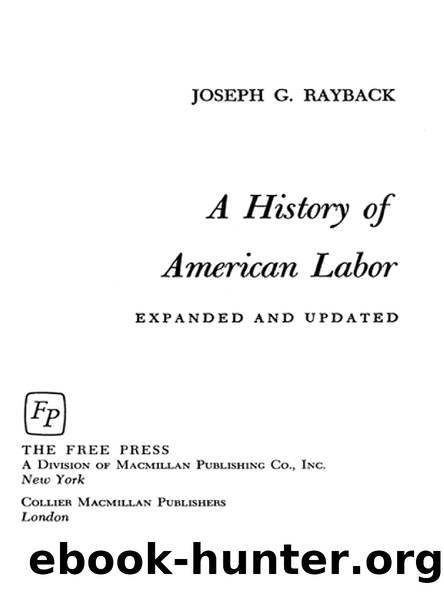A History of American Labor by JOSEPH G. RAYBACK

Author:JOSEPH G. RAYBACK
Language: eng
Format: epub
Tags: SOC035000
Publisher: THE FREE PRESS
Published: 1966-07-15T00:00:00+00:00
The Federation’s Revival
The years between 1904 and 1911 were very unhappy ones for the American Federation of Labor. They were years when the very existence of the A.F.L. was seriously challenged by an open-shop campaign that swept it from a vast number of the nation’s towns and small cities, when internal disgruntlement became strong, and when many of its activities were hampered by the Federal courts. They were also years when the A.F.L. was challenged in the labor world itself—by the socialists whose constant reiteration of the idea that labor could better itself by political action won many supporters, and by the W.F.M. and I.W.W. forces which appealed to many laboring men with their doctrine of industrial unionism and direct action.
The American Federation of Labor was keenly aware of its problems. It had recognized the threat presented by the doctrine of industrial unionism at the Scranton convention when it had permitted the U.M.W. to enroll the craftsmen who worked around the mines. With the formation of the I.W.W. it also surrendered to the United Brewery Workers. But it had regarded these concessions as exceptions to, and not as contraventions of, its principle of craft autonomy. When the demand for recognition of industrial unionism continued to grow, the A.F.L. began to realize the need for a more practical solution. It found the answer in the trades council, which had long been used locally in the building trades. As late as 1905 the A.F.L. denounced as dual unionism any attempt to federate local buildingtrade councils into a national organization. In 1907 its attitude on the subject suddenly changed. It created a Building Trades Department of all building trade unions inside the federation for the express purpose of adjusting jurisdictional disputes and of aiding each other through the sympathetic strike. Other similar organizations followed: a Metal Trades Department was set up in 1908 to offset the secession of the United Metal Workers; a Railway Employees Department made up of the railway shop crafts was established in the same year; a Mining Department was evolved out of the U.M.W. and the Smelters Union in 1912. Despite all attempts to justify these actions in craft-union terms, they were obviously efforts to compromise with “industrialism.” Their purpose was to unite a number of trades into a fighting unit upon an industry-wide front, almost exactly the object of an industrial union.
“Departmentalization” satisfied many, but not all, industrial unionists. In 1912-1913 the industrial-union movement was given a boost by the spectacular activities of the I.W.W. in the East and by the election of officials who favored industrial unionism to the leadership of the machinists, miners, and tailors. The Executive Council, recognizing the trend, bent a little more, with the announcement that the Scranton Declaration did not prevent the extension of union membership to the unskilled, nor did it prevent an amalgamation of labor unions. The announcement, and the opiate-like effects of the prosperity that preceded the opening of the First World War, temporarily ended the agitation.
The A.F.L.’s recognition
Download
This site does not store any files on its server. We only index and link to content provided by other sites. Please contact the content providers to delete copyright contents if any and email us, we'll remove relevant links or contents immediately.
International Integration of the Brazilian Economy by Elias C. Grivoyannis(57286)
The Radium Girls by Kate Moore(10902)
Turbulence by E. J. Noyes(7032)
Nudge - Improving Decisions about Health, Wealth, and Happiness by Thaler Sunstein(6629)
The Black Swan by Nassim Nicholas Taleb(6184)
Pioneering Portfolio Management by David F. Swensen(5599)
Rich Dad Poor Dad by Robert T. Kiyosaki(5140)
Zero to One by Peter Thiel(4817)
Man-made Catastrophes and Risk Information Concealment by Dmitry Chernov & Didier Sornette(4728)
Secrecy World by Jake Bernstein(3773)
Millionaire: The Philanderer, Gambler, and Duelist Who Invented Modern Finance by Janet Gleeson(3565)
Skin in the Game by Nassim Nicholas Taleb(3456)
The Age of Surveillance Capitalism by Shoshana Zuboff(3411)
The Money Culture by Michael Lewis(3276)
Skin in the Game: Hidden Asymmetries in Daily Life by Nassim Nicholas Taleb(3259)
Bullshit Jobs by David Graeber(3172)
The Dhandho Investor by Mohnish Pabrai(3161)
The Wisdom of Finance by Mihir Desai(3069)
Blockchain Basics by Daniel Drescher(2884)
